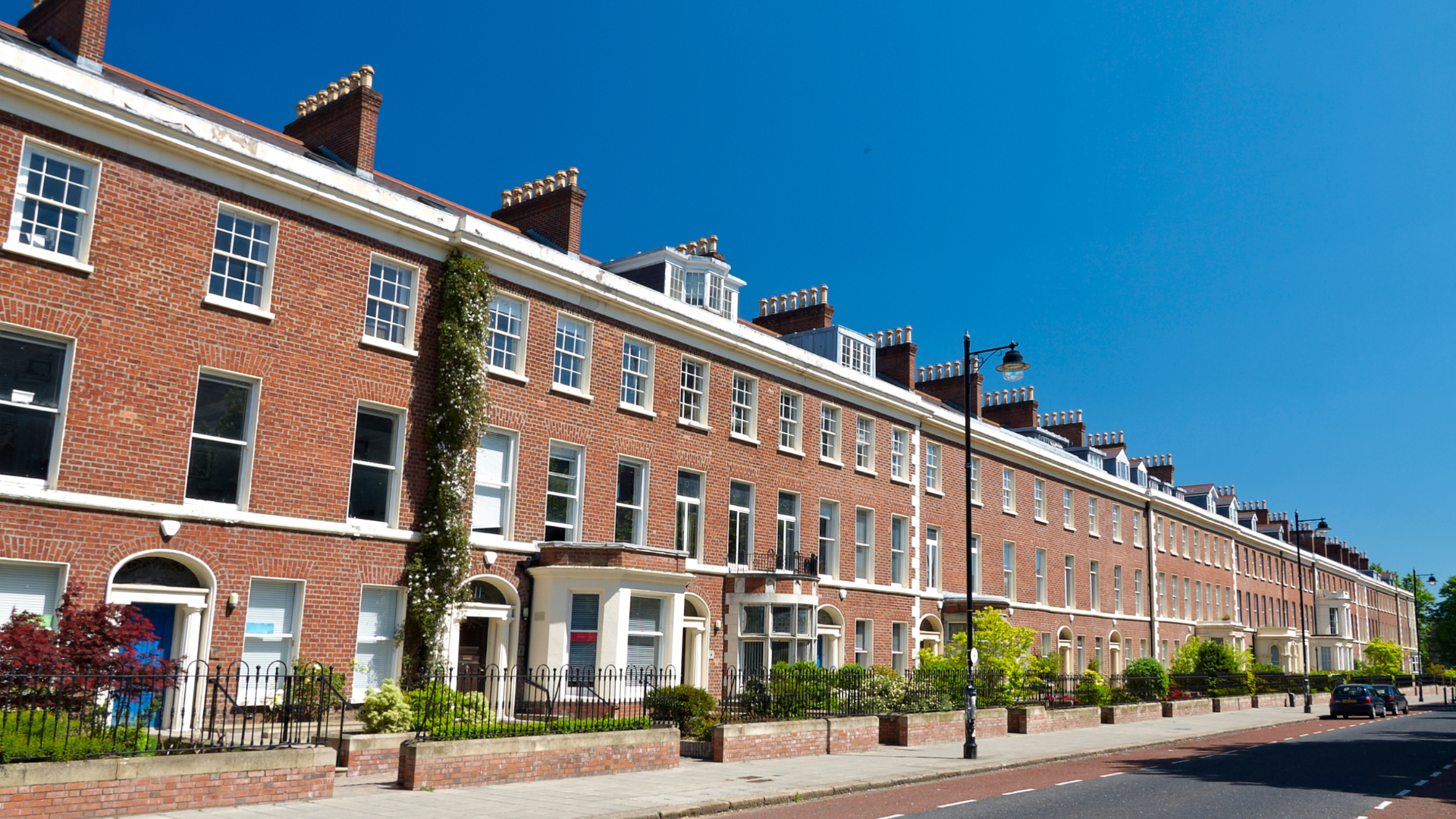- How Does Buy To Let Mortgages Work in Northern Ireland?
- Who Is Eligible for a Buy-to-Let Mortgage in Northern Ireland?
- What Are the Current Interest Rates for Buy-to-Let Mortgages?
- How Much Can You Afford?
- Which Lenders Offer Buy-to-Let Mortgages in Northern Ireland?
- Landlord Licensing Requirements
- What Are The Taxes I Need To Pay?
- Can I Get A Buy To Let As Limited Company In Northern Ireland?
- Rent-to-Buy Scheme in Northern Ireland
- Key Points Before Securing A Buy To Let Mortgage
- Key Takeaways
- The Bottom Line: How To Get Buy-To-Let Mortgages?
How To Get Buy-To-Let Mortgages In Northern Ireland?

Northern Ireland offers a lot of opportunities for buy-to-let investors like you.
Bargain property prices, a keen demand for rentals, especially in lively cities like Belfast, and an economy that’s on the up, giving property values a nice little boost.
But, getting your hands on a buy-to-let mortgage here might be a bit different from the rest of the UK.
The choice of lenders can be a bit slim, so you’ve got to dig a bit deeper to find the top deals.
This guide is here to walk you through what to expect and how to tackle the process with ease.
Ready to crack on?
How Does Buy To Let Mortgages Work in Northern Ireland?
A buy-to-let mortgage lets you invest in property to rent out.
Unlike residential mortgages, these secured loans consider your potential rental income rather than your personal income.
One key difference in Northern Ireland, compared to the rest of the UK, is the range of lenders and deals available.
You might find fewer lenders than in the rest of the UK. This means you need to carefully search for good deals – and it might not be easy to go it alone.
The process for getting a mortgage here is similar to that in the rest of the UK, which involves property selection, mortgage application, and underwriting.
But, as an investor, you must be ready to face different local rules, market conditions, and responsibilities.
Who Is Eligible for a Buy-to-Let Mortgage in Northern Ireland?
To get a buy-to-let mortgage, you need to meet several specific criteria. While each lender has its requirements, here are some common expectations:
- Deposit. Lenders usually require a deposit of 25% to 30% of the property’s purchase price. To access more favourable deals, a deposit of 40% or more could be beneficial.
- Rental Yield. Lenders want the rent you charge to cover 125% to 145% of the mortgage payment. This means if your mortgage costs you £500 a month, you should aim to charge at least £625 in rent. This ensures you can cover your mortgage payments and any unexpected costs.
- Location and Property Type. Rural properties or those considered non-standard construction (e.g., farmhouses, thatched roofs) might be seen as higher risk, potentially requiring a larger deposit. HMO properties may also impose additional limitations.
- Experience as a Landlord. First-time buyers might find it challenging to secure a buy-to-let mortgage due to perceived increased risks. Demonstrating financial stability and knowledge of property management can help.
- Regulatory Requirements. Registration under the Landlord Registration Scheme is mandatory, alongside obtaining the necessary licences for HMO properties or holiday lets, as per local regulations.
Meeting these criteria is just the beginning.
Prospective landlords should also consider the rental yield of the property, their financial health, and long-term investment goals.
>> More about Buy To Let Eligibility Criteria
What Are the Current Interest Rates for Buy-to-Let Mortgages?
Buy-to-let mortgage rates can change.
They are influenced by things like the Bank of England’s base rate, property location, potential rental income, and creditworthiness.
If you’re borrowing less compared to your property’s value (a lower LTV), you usually get better rates.
While average rates can give you an idea, expect differences from one deal to another. In Northern Ireland, rates are generally in line with the rest of the UK, though the exact rate you get could vary because of local factors.
To get the most accurate rates that fit your specific needs, talking to a mortgage broker is your best bet. They can offer personalised advice and find the best rates available for you.
How Much Can You Afford?
To work out what you can afford for a buy-to-let mortgage, let’s look at how lenders do it:
1. Look at Your Deposit
First up, see how much deposit you’ve got. We’ve discussed earlier that you’ll need about 25% to 30% of the property’s price for a buy-to-let mortgage.
If you can stretch to 40%, even better deals might be available.
2. Calculate Your Potential Rental Income
Lenders use a quick check, called a rental stress test, to see the biggest mortgage your rent could cover. Typically, your rental income needs to be at least 125% to 145% of your mortgage payments.
The more rent you can charge, the larger the mortgage you might get.
For example, if your property’s expected rental income is £12,000 a year from rent, and the lender wants a 125% coverage ratio.
Here’s a simple way to see what monthly mortgage payment this rent could support:
- Annual Rental Income / Coverage Ratio = Maximum Annual Mortgage Payment
- £12,000 / 1.25 = £9,600
- £9,600 / 12 = £800 per month
With the £800 per month figure, lenders calculate backwards, considering their interest rates and mortgage terms, to find the maximum loan they’ll offer you.
Keep in mind, that most lenders will only lend up to 85% of the property’s value.
To get a clearer idea of your rental yield, you can use the calculator provided below.
This tool helps you understand the rental yield of your investment property, based on its purchase price and related expenses, or its present market value. Simply select your calculation basis and enter your monthly rent to see your results.
[Embedded Rental Yield Calculator]
3. Talk to a Mortgage Broker
They can give you advice tailored to your situation and help you figure out how much you can afford for a buy-to-let mortgage in Northern Ireland.
You can also use the buy-to-let calculator below to get an estimate of your borrowing amount.
[Embedded Buy To Let Mortgage Calculator]

Which Lenders Offer Buy-to-Let Mortgages in Northern Ireland?
In Northern Ireland, you won’t find lenders that only focus on this area. Instead, you have a choice of UK-wide banks for your mortgage. These include:
- Danske Bank
- Bank of Ireland
- HSBC
- NatWest
- Santander
- The Mortgage Works (Nationwide’s specialist buy-to-let branch)
- Barclays
Remember, there are more options out there. Whether you’re starting or growing your property investments, talking to a mortgage adviser is a smart move. They can help you find special deals and give advice tailored to your needs.
Landlord Licensing Requirements
In Northern Ireland, if you want to rent out a property, you need to register as a landlord. It’s a simple process but necessary. Here’s what you need to know:
- Registration – All landlords must register with the Landlord Registration Scheme. This helps ensure that rental properties meet safety and living standards.
- Fee – There’s a fee for registering, which is £70. This covers you for three years. After that, you’ll need to renew your registration.
- Information Required – When registering, you’ll provide details about yourself and your rental properties. This includes locations and types of properties you’re renting out.
- HMO Licensing – If you have a House in Multiple Occupation (HMO) – meaning shared by three or more tenants, not from one household – you need a separate licence. This ensures the property is safe and well-managed.
- Holiday Lets – Planning to rent your property as a holiday home? You might need approval from Tourism NI. This ensures your property meets the standards for tourist accommodations.
Remember, these steps are there to protect you, and your tenants, and to keep the rental market fair and safe. Always check for the latest requirements or changes in the law.
What Are The Taxes I Need To Pay?
Besides the mortgage and the upkeep costs of the property, you’ll need to pay taxes. Here’s a lowdown of the
Stamp Duty Land Tax (SDLT)
This is paid when you purchase the property. It’s based on the property’s price, with higher prices paying more tax. These rates include the additional 5% charge for buy-to-let properties.
Here are the current bands:
| Property Price (£) | SDLT Rate (Buy-to-Let) |
|---|---|
| £0 – £40,000* | 0% |
| £40,001 – £250,000 | 5% |
| £250,001 – £925,000 | 10% |
| £925,001 – £1.5m | 15% |
| Over 1.5m | 17% |
Income Tax on Rental Income
You need to pay tax on the rent you receive. This tax rate varies with your total income, from 20% for basic rate taxpayers to 40% or 45% for those in higher brackets.
Mortgage Income Tax Relief
Northern Ireland follows the UK’s tax rules. Since April 2020, the way landlords get tax relief on mortgage interest has changed.
You can’t deduct mortgage payments from your rental income anymore.
Instead, you get a tax credit worth 20% of your mortgage interest payments. And, if you’re in a higher tax band, you might pay more tax than before.
Capital Gains Tax (CGT)
If you sell the property for more than you bought it, you’ll pay CGT on the profit. The current rates for property are 18% for basic rate taxpayers and 24% for higher rate taxpayers.
Corporation Tax
If your property is owned by a limited company, it’s not income tax but corporation tax you’ll need to worry about. The current rate is 19%, but it’s applied to the company’s profits.
This setup lets you deduct costs like mortgage interest before calculating tax, which can mean paying less overall. It’s one reason why going the limited company route is becoming popular among investors.
Can I Get A Buy To Let As Limited Company In Northern Ireland?
Yes, you can get a buy-to-let mortgage as a limited company in Northern Ireland, but options are limited.
Few lenders offer these mortgages to limited companies. Some even say upfront they won’t lend to borrowers if the property is owned by a limited company.
However, if you find a lender that meets your needs, there are tax benefits to getting a mortgage through a limited company.
Meeting the lenders’ criteria is key to accessing these benefits.
Always check with a mortgage advisor who understands the local market to find your best options.
Rent-to-Buy Scheme in Northern Ireland
The Rent to Buy scheme, also known as Rent to Own in Northern Ireland, is run by OwnCo Homes. It’s aimed at helping you get on the property ladder if you’re not ready to buy just yet.
You start by renting the home of your choice, with a chance to buy it within three years. You’ll pay a deposit and a down payment at the beginning, and while you rent, you’ll get a rebate to help build a deposit for purchasing the home.
To qualify, you need to:
- Pay a non-refundable assessment fee of £100.
- Pass a credit check and an affordability review.
- Choose a newly built home valued up to £190,000.
- Ensure the home is ready within six months and has at least two bedrooms.
- Look for properties offering a turnkey package and a 10-year structural warranty.
This scheme helps you move towards owning a home by saving for a deposit while living in it. Note: criteria can differ between lenders, and it’s not for buying to let properties.
Key Points Before Securing A Buy To Let Mortgage
Do
- Thoroughly research the rental market.
- Upgrade the property to appeal to tenants.
- Assess all expenses to ensure affordability.
- View the investment with a long-term perspective.
- Save a substantial deposit to secure better mortgage rates.
- Get familiar with landlord responsibilities and legal requirements.
Don’t
- Buy properties that require extensive repairs.
- Rely on friends or family for property management; professional services might be more reliable.
- Skimp on legal paperwork like tenancy agreements.
- Ignore landlord insurance to cover potential damages or rental defaults.
- Forget to consider periods when the property might be vacant.
Key Takeaways
- Buy-to-let mortgages in Northern Ireland focus on rental income, not your personal salary, but there are fewer lenders compared to the rest of the UK. It’s worth getting help from a broker to find the best deals.
- You’ll need at least a 25%-30% deposit (or 40% for better rates) and rental income that covers 125%-145% of your mortgage payments. Non-standard properties or first-time landlords may face tougher rules.
- Expect to pay taxes like Stamp Duty (5%-17% for buy-to-lets) and income tax on rental earnings, plus fees for landlord registration, HMOs, or legal costs.
- Limited company buy-to-let mortgages are an option, but fewer lenders offer them. They might be worth exploring for potential tax benefits.
- The Rent to Buy scheme in Northern Ireland is great for first-time buyers but isn’t for investment properties. It lets you rent a home while saving up to buy it within three years.
The Bottom Line: How To Get Buy-To-Let Mortgages?
Starting with a chat with a buy-to-let mortgage broker who knows Northern Ireland well is a clever first step.
Here’s what they can do for you:
- Save you time by searching through lenders who have a wide range of mortgage options tailored to your needs.
- Understand your investment goals and needs, tailoring their advice to match your long-term plans.
- Gather your documents and review your creditworthiness to ensure your application is strong.
- Help you understand all the costs involved, from stamp duty to management fees, so there are no surprises.
- Advise you on which property locations offer the best rental yield and growth potential.
- Provide insight into the local property market, helping you make informed decisions.
- Boost your mortgage chances because they understand exactly what lenders are looking for in applicants.
- Negotiate better mortgage terms on your behalf, potentially saving you money over the long term.
In a nutshell, a mortgage broker can be your guide through the entire process, making it smoother and more likely to succeed.
Unsure where to find the right broker? Get in touch. We’ll set up a free, quick, no-obligation consultation with a buy-to-let mortgage broker to help you kickstart your journey.
Get Matched With Your Dream Mortgage Advisor...

Frequently asked questions
What's the prime spot in Northern Ireland for buy-to-let properties?
Belfast is a top choice for buy-to-let investments due to its strong rental demand, driven by students and professionals. Other areas with potential include Dungannon, Lisburn, and Omagh, thanks to their growing economies and populations.
Can you get repayment mortgages for buy-to-let in Northern Ireland?
Yes, you can find repayment mortgages for buy-to-let properties in Northern Ireland. These allow you to pay off both the interest and capital over time.
What kind of insurance do landlords need?
Landlords should consider landlord insurance, which covers building damages, loss of rent, and sometimes, contents. It’s crucial for protecting your investment against unexpected events.




